We're all about green grass and grazers this month on Naked Oceans as we take a look at the lush world of seagrasses. We find out why the diversity of critters, big and small, are vital for keeping seagrasses happy and healthy. We meet a mysterious seagrass muncher, the West African manatee and we discover that seagrasses themselves could be the oldest living things on the planet. Among our ocean news we hear how corals find it tough when things get too hot, and too cold; and in Critter of the Month we catch up with a sneaky fish that lurks about the dark depths with its own private sniper scope.
In this episode

Studying seagrasses: from plastic bucket to planet
with J. Emmett Duffy, Virginia Institute of Marine Science
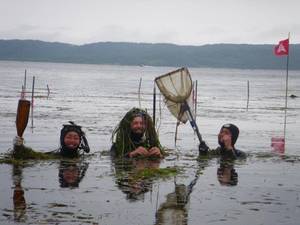 Emmett: Seagrasses face a lot of the same threats that many other ocean habitats do. On a local level they're threatened by nutrient pollution, runoff from land, farms in domestic regions, which causes algae to overgrow them, and also soil erosion which causes the water to be turbid and dirty. Seagrasses are plants, of course, so they need a lot of light and they need clear water to grow.
Emmett: Seagrasses face a lot of the same threats that many other ocean habitats do. On a local level they're threatened by nutrient pollution, runoff from land, farms in domestic regions, which causes algae to overgrow them, and also soil erosion which causes the water to be turbid and dirty. Seagrasses are plants, of course, so they need a lot of light and they need clear water to grow.
On a global scale seagrasses are threatened by climate change as well. Like corals, they tend to be at least in temperate areas like N America and Europe, they tend to be living near their upper thermal tolerances, meaning that a little bit of a rise in temperature can push them over a tipping point. And we're beginning to see that both in the Chesapeake Bay here in the US, as well as in the Mediterranean.
Sarah: What would it mean if we started to loose these beds? Are we already seeing a decline?
Emmett: Yes, there's been quite a large decline in the coverage of seagrass over the last several decades. In the US for example I think that it's estimated that something like 70% of the seagrass coverage has been lost. And that's a problem for a number of reasons. You can think of an analogy with grasslands on land, the grass holds the soil together, it helps build soil, it obviously supports livestock that graze on it and all kinds of animals.
It's actually quite similar in the sea. The seagrasses bind sediments together and help store organic matter, they can sequester carbon out of organic matter in the water column. They provide direct food for large animals like turtles and manatees and dugongs, but probably even more importantly the grasses and the algae that are growing on them provide a lot of food and habitat for all kinds of small invertebrates that are near the base of the food change. So many fishes and shellfish use seagrass beds as nursery areas.
There are a number of commercial fisheries that depend on seagrass beds because the baby fish live in the seagrass beds and that's an important part of their life history.
Sarah: It can be quite tough to go and experiment and have a look at this kind of ecosystem in the wild, so I understand you've done a lot of 'mesocosm' experiments. How do you go about studying an ecosystem in the lab?
 Emmett: The mesocosm is the geekish word we use for trying to recreate a small version of an ecosystem. The problem that we face is that the major herbivores, the animals that eat the plants and start the process of energy flow up the food chain in seagrass beds those animals are primarily really small invertebrates, sea bugs if you will, these are little crustaceans. It's very difficult to manipulate them in the field to try and find out what they're doing.
Emmett: The mesocosm is the geekish word we use for trying to recreate a small version of an ecosystem. The problem that we face is that the major herbivores, the animals that eat the plants and start the process of energy flow up the food chain in seagrass beds those animals are primarily really small invertebrates, sea bugs if you will, these are little crustaceans. It's very difficult to manipulate them in the field to try and find out what they're doing.
So what we've done is to bring the ecosystem into the lab, not strictly the lab, but outdoor tanks, where we've planted seagrass and we have sea water flowing through them. And we've been able to put different kinds of animals into these grass beds to see what effect they have on the grass.
I mentioned earlier that the grass in important to the animals because it provides habitat. It's also true that some of these small animals are important to the grass. So it's what you might call a mutualistic interaction - you scratch my back, I'll scratch yours.
The way it works it that the seagrasses can be overgrown by nuisance algae, pond scum for example, that are superior competitors except that these small crustaceans eat that algae and therefore create conditions that are favourable for the grass. That's the kind of thing that we've been trying to figure out using the mesocosms that's very difficult to do in the field.
Sarah: And you've also received a grant to move that out into the real ecosystems. How do you go about moving your experiments from something like these fairly controlled conditions out into something where you don't necessarily have a lot of control over the variables.
Emmett: There are different questions that one can ask under those different 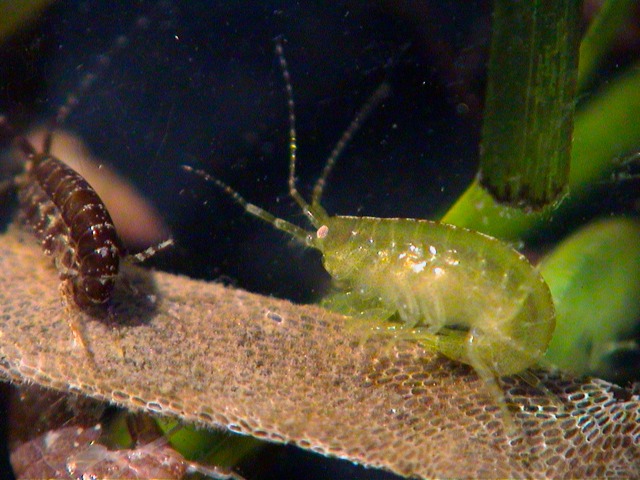 circumstances. So in the mesocosm experiments we've been able to look in a lot of detail under highly controlled conditions at what different species are doing, manipulated the number of species of small animals to ask whether diversity makes a difference, does it matter if you have one kind of grazer or 5 or 6 kinds of grazers. That's much more difficult to do out in the real world. So there's that disadvantage. But of course the real world is what we really want to know about.
circumstances. So in the mesocosm experiments we've been able to look in a lot of detail under highly controlled conditions at what different species are doing, manipulated the number of species of small animals to ask whether diversity makes a difference, does it matter if you have one kind of grazer or 5 or 6 kinds of grazers. That's much more difficult to do out in the real world. So there's that disadvantage. But of course the real world is what we really want to know about.
So what we've been able to do is to set up simpler experiments out there where we simply get rid of all grazers, all of these small invertebrates to find out whether that has an influence on the grass. We've done that with a degradable insecticide that is put into a slow release plaster block, so we can see what impact that has on the plants.
But is doesn't have all of the problems associated with putting a cage out in the field because cages can shade the grass and they attract fouling organisms, and sediment and all kind of stuff.
So the questions are somewhat simpler, but of course because they're done out in the actual seagrass beds with all the other forces happening in nature we get a more accurate estimate of what the effects of those grazers might be.
So we've run the same experiment at 15 different sites worldwide from Japan through both coasts of North America to Scandinavia and Portugal. And we find that there's quite a bit of variability. So in the coming year we're hoping to try and figure out why that is and part of it has to do with seasonality that there's some times of year when the grazers are active and algae growth is strong and others when that's not the case. And also there's of course geographic variation in what factors are most important.
Sarah: And how do you see these results being used going forward? Can we use them to perhaps direct conservation efforts?
 Emmett: Well I hope so. It'll certainly be important to know what the major factors influencing seagrass ecology and populations are. A lot of the work that we've done in seagrasses is uncovering the importance of some of these really small inconspicuous marine animals that nobody ever thinks about, the bugs and slugs if you will.
Emmett: Well I hope so. It'll certainly be important to know what the major factors influencing seagrass ecology and populations are. A lot of the work that we've done in seagrasses is uncovering the importance of some of these really small inconspicuous marine animals that nobody ever thinks about, the bugs and slugs if you will.
Some years ago the famous biologist EO Wilson said that insects are the little things that run the world because they're very important in terms of nutrient cycling and maintaining the structure of plant communities.
And I think what we're beginning to find out with some of this work is that the same thing is true in the oceans that some of these tiny marine animals that no one pays attention to can have very large impacts on systems that are important to maintaining it in working order.
We all love whales and turtles and so on but we also need to love the bugs and slugs.
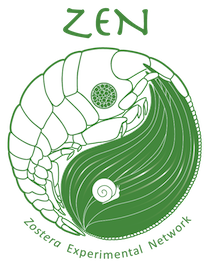 Find out more:
Find out more:
ZEN (The Zostera Experimental Network)
Marine Biodiversity Lab, VIMS
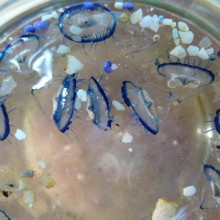
09:38 - The aquatic problems of microplastics
The aquatic problems of microplastics
Helen: Plastic debris - it's a growing ocean concern, and for a while now it's been known that a growing abundance of the plastic that's hanging around in the marine environment comes in the form of tiny particles, or microplastics, that are less than 1 mm in size. But where's it all coming from? That's the big question tackled by a team of researchers led by Mark Browne from the University of California, Santa Barbara and Richard Thompson from Plymouth University.
Their paper first came out late last year, and I had a chance to catch up with Richard and find out more about their forensic approach to identifying the source of polluting plastic.
Richard: 2004 we published a paper showing that small fragments of plastic, microscopic pieces, some less than the diameter of a human hair were accumulating in the oceans and that they had increased over time. So the key question was "where is that material coming from and to what extent was it causing harm." And over the last 10 years we've examined a number of different roots at the University of Plymouth, we've looked at razor fragmentation of larger items of debris and we know they contribute to the picture. We've looked at direct releases of small pieces of plastic into the environment, pieces of plastic, for example, that are used as abrasive scrubbers in cleaning products. Pieces less than a millimeter or so in size and yet many tones released to the oceans through sewage and waste water.
But another line of inquiry that we wanted to pursue was some of the material, the microscopic material, we were finding was fibrous in shape and it occurred to us that some of this could be resulting from the cleaning both at home and at in industrial settings of fabrics and textiles resulting in accumulation of small fibres that wouldn't necessarily be removed by any form of sewage treatment.
Helen: Richard, Mark and their team set out and took samples of sediments from shorelines in 18 sites spanning the globe, on six continents, and found microplastic everywhere. The team them zeroed in on the possible source of these fibres.
Richard: We found quite substantial quantities of fibres being released at the end of a washing machine pipe. We found similarly fibres being released from sewage treatment plants and we found in the UK despite the fact that dumping of sewage sludge stopped over ten years ago there was abundance of this kind of synthetic fibre at sites that were formerly used as dumping grounds than in nearby reference sites.
Helen: So what is the likely impact of all this plastic on marine life?
 Richard: We know from laboratory studies that creatures with a range of different feeding mechanisms: barnacles and muscles that filter their food from the water column, marine worms that live in sediments and effectively strip their organic matter from those sediments, and detritivores things like sand hoppers that live at the top of the shore. All of those creatures will ingest material of this size in laboratory exposures and indeed with the muscles we did here at Plymouth showed that after a single exposure and then moving the muscles to clean conditions, even after more than 40 days, those muscles have still got plastic in their system.
Richard: We know from laboratory studies that creatures with a range of different feeding mechanisms: barnacles and muscles that filter their food from the water column, marine worms that live in sediments and effectively strip their organic matter from those sediments, and detritivores things like sand hoppers that live at the top of the shore. All of those creatures will ingest material of this size in laboratory exposures and indeed with the muscles we did here at Plymouth showed that after a single exposure and then moving the muscles to clean conditions, even after more than 40 days, those muscles have still got plastic in their system.
And so there is some suggestion that these small fragments of plastic can accumulate in the tissues of organisms in a way that we wouldn't expect from the natural food source. That still doesn't prove that it is doing those creatures any harm but I think it is an important step on the way to establishing what harm it might cause. You need to know where this kind of material is, what creatures might be eating it, and then you can look at a kind of risk assessment to exposure pathway.
Helen: It's well known that larger animals, especially marine birds, can get tangled in bigger plastic debris, they choke and fill up their stomachs when they try and eat it, and its possible that for smaller animals, these smaller bits of plastic could have a similar effect.
A further concern, surrounds the possibility that very small pieces of plastic could transport and release chemicals found in the environment from other sources.
Richard: A lot of the chemicals of concern here are hydrophobic in nature and so they will latch on to plastics in preference to water. So a small piece of plastic exposed in the sea within a space of a week or so will dissolve a concentrate on its surface, concentrations of some of those chemicals that can be many, many fold the concentrations in the surrounding sea water. So that's a potential if those plastics are then eaten, different chemical environment could those chemicals then be released.
And that's in addition to existing concerns about some of the chemicals that are used in the production of a variety of plastics. Used with good purpose in mind, but things we are now regulating from a human health perspective such as thalates in plastics. So some of the chemical additives that are introduced for functionality might also be released more readily when you are dealing with very small particles.
So I think the overriding message here is that these small synthetic fibres are an additional part of the problem, they are an additional source of these microscopic particles which has really been the overarching aim of our studies to examine.
Helen: A team in Japan are running a project called International Pellet watch - Velellas (by-the-wind-sailors) and plastic confetti in the North Pacifc Plastic Gyrethey're asking members of the public to send in tiny particles of plastic - so they can analyse and map out the global distribution of these hydrophobic organic pollutants that stick to plastic in the ocean - so if you want find out what chemicals are found on your local beach then check out pellet watch.org.
Plastic debris in the oceans is obviously a huge topic with all sorts of conservation implications, and you can find out more from a recent report that Richard co-wrote for the Global Environment Facility, you can download that from our website.
But as his study showed, if all these plastic fibres are washing out of our clothes - up to 1900 fibres each time a single fleece is washed, the team estimate - then is the solution simply to get the washing machine engineers to come up with better filters so these fibres don't end up in sewage water in the first place?
Richard: Its part of the picture, fixing the quantities of small synthetic fibres passing from waste water pipes is not to solve the problems of pollution of the oceans by solid marine debris, a large proportion of which is plastic items , rope, netting, packaging and what we're discussing here with respect to fibres in washing machines is part of the story but is not going to solve it on its own.
Find out more:
Browne et al (2011). Accumulation of microplastic on shorelines worldwide: sources and sinks.
Environmental Science and Technology.
Marine Debris as a global environmental problem - Global Environment Facility report [PDF]
Pellet Watch

15:42 - Corals stressed by heat and cold
Corals stressed by heat and cold
 We know increased temperatures can stress corals and cause bleaching - which is when they symbiotic algae that produce energy for the corals are lost, causing the coral to turn white, stop growing and often die. But, with climate change, corals are often subjected to extremes of both heat and cold.
We know increased temperatures can stress corals and cause bleaching - which is when they symbiotic algae that produce energy for the corals are lost, causing the coral to turn white, stop growing and often die. But, with climate change, corals are often subjected to extremes of both heat and cold.
And now, a study published in Scientific Reports has shown that both heat and cold can stress corals, but they do so in different ways.
Melissa Roth, Ralf Goericke and Dimitri Deheyn from Scripps Institution of Oceanography studied an important species of reef building coral called Acropora by growing fragments in individual tanks and then subjecting them to a change in temperature - either plus or minus 5 degrees C from an original temperature of 26 degrees C.
The team found that Acropora subjected to a decrease in temperature showed a greater decline in growth and the amount of photosynthetic symbionts in their cells in the first 5 days of the experiment than those that were heat treated. This could be because the enzymes required for photosynthesis work more slowly at lower temperatures and because cold shock can cause the coral cells containing the symbionts to be jettisoned into the water.
However, over the final 15 days of the 20 day experiment, the cold treated corals fared much better. They acclimated and began to recover their growth rate and stabilise their symbiont numbers. In contrast, heat treated corals did progressively worse with prolonged exposure to increased temperature. Photosynthesis decreased and eventually the corals bleached and stopped growing.
The authors suggest that although temporary extremes of cold could threaten corals, it is a prolonged increase in temperature that is more damaging, which is worrying given the increases in temperature seen in many areas of the ocean.

17:50 - Seagrasses; the oldest living things on the planet
Seagrasses; the oldest living things on the planet
Seagrass meadows in the Mediterranean could be the oldest living things on the planet, dating back hundreds of thousands of years.
 As well as reproducing sexually like all flowering plants, seagrasses have the habit of spreading by dividing and cloning themselves, and the Mediterranean species, Posidonia oceanica, is no exception. DNA analysis of genetically identical swathes of seagrasses, in areas between Spain and Cyrpus, has revealed their great age - the oldest patch found off the Spanish Island of Formentera is estimated to be 200,000 years old - it's been sitting around on the seabed, steadily and slowly dividing for longer than modern human beings have walked the earth.
As well as reproducing sexually like all flowering plants, seagrasses have the habit of spreading by dividing and cloning themselves, and the Mediterranean species, Posidonia oceanica, is no exception. DNA analysis of genetically identical swathes of seagrasses, in areas between Spain and Cyrpus, has revealed their great age - the oldest patch found off the Spanish Island of Formentera is estimated to be 200,000 years old - it's been sitting around on the seabed, steadily and slowly dividing for longer than modern human beings have walked the earth.
This shows that seagrasses are able to adapt to changing conditions that have taken place in the past, but doesn't necessarily mean they will cope with the changes human activities are throwing at them, because the rates of change today of things like water temperature and pH are so much faster than is has been in the past.
Find out more:
Duarte (2012). Implications of extreme lifespan in clonal organisms: millenary clones in meadows of threatened seagrass Posidonia oceanica.
PLoS ONE (Open Access)
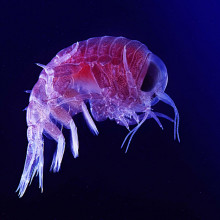
19:28 - 'Supergiant' amphipods found
'Supergiant' amphipods found
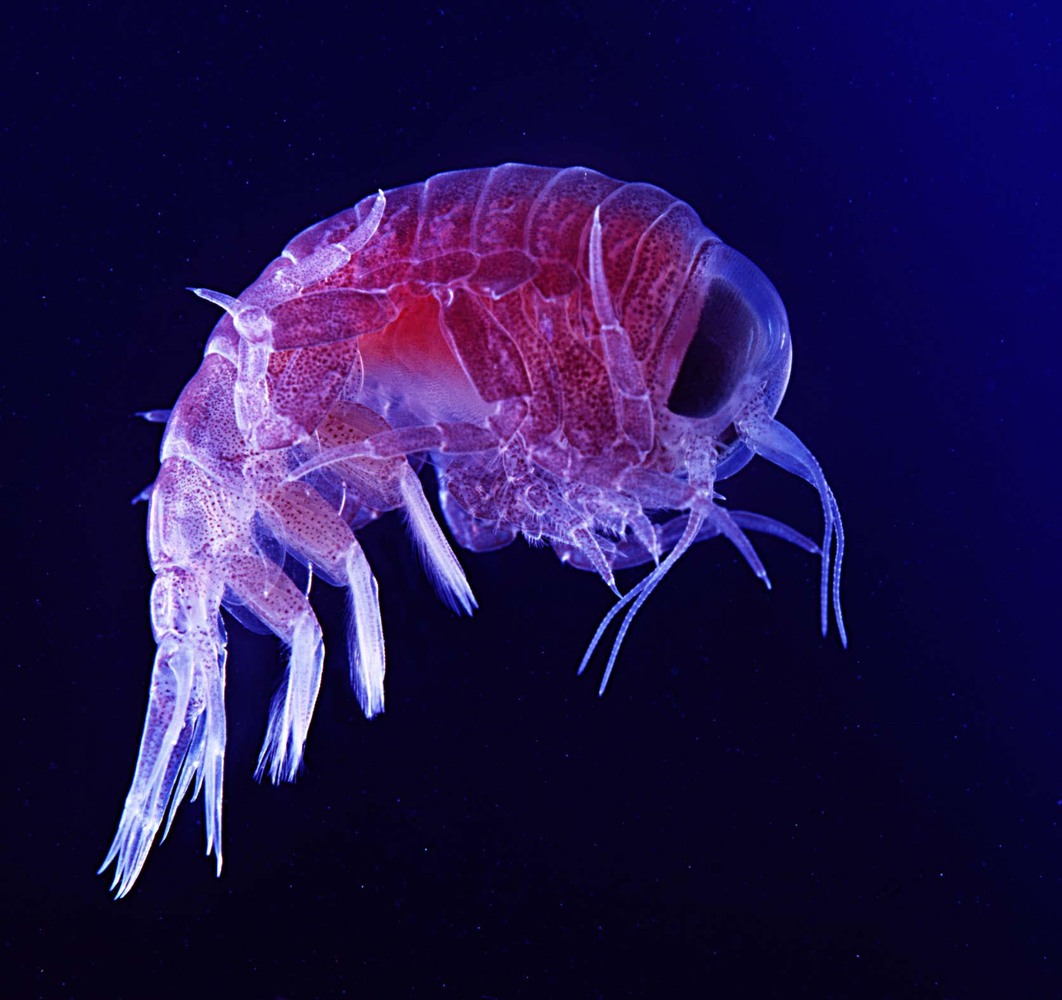 Researchers exploring 7000m down in the Kermadec Trench, just north of New Zealand have found a new 'supergiant' species of amphipod, which is a type of crustacean that looks a bit like a heavily armoured prawn. The interesting thing about the specimens, which were around 30cm or a foot long, compared to most amphipods which are only a few centimetres or inches long, was that when the researchers took their camera and trap system back to the trench a few days later, the amphipods were nowhere to be seen! An intriguing glimpse into the mysterious world of the deep sea!
Researchers exploring 7000m down in the Kermadec Trench, just north of New Zealand have found a new 'supergiant' species of amphipod, which is a type of crustacean that looks a bit like a heavily armoured prawn. The interesting thing about the specimens, which were around 30cm or a foot long, compared to most amphipods which are only a few centimetres or inches long, was that when the researchers took their camera and trap system back to the trench a few days later, the amphipods were nowhere to be seen! An intriguing glimpse into the mysterious world of the deep sea!

20:35 - Unlocking secrets of the West African manatee
Unlocking secrets of the West African manatee
with Lucy Keith Diagne, Sea to Shore Alliance
Helen: The least well known of the sirenia is the West African Manatee. As the name suggests, they live along the west coast of Africa, they have a huge range from Senegal down to Angola, and they can also move hundreds of mile inland along rivers.
Someone who knows more than anyone else about these mysterious marine mammals is researcher and conservationist, Lucy Keith Diagne. She told me how she was first tempted to visit west Africa in search of manatees.
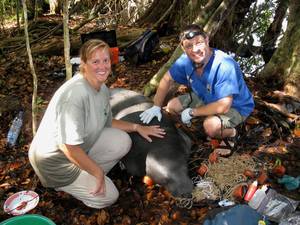 Lucy: I had actually been working with manatees in Florida and the Caribbean for 6 years when I went to a scientific meeting, a marine mammology conference. And just by pure coincidence I met there a humpback whale researcher who was working in Gabon, West Africa. And he mentioned to me that each day as he traveled to his study site out in the Atlantic Ocean in Gabon he was actually passing a lot of West African manatees. From everything he heard they were quite rare but here he was seeing them daily. He thought that was pretty interesting.
Lucy: I had actually been working with manatees in Florida and the Caribbean for 6 years when I went to a scientific meeting, a marine mammology conference. And just by pure coincidence I met there a humpback whale researcher who was working in Gabon, West Africa. And he mentioned to me that each day as he traveled to his study site out in the Atlantic Ocean in Gabon he was actually passing a lot of West African manatees. From everything he heard they were quite rare but here he was seeing them daily. He thought that was pretty interesting.
Helen: Lucy ended up spending the next 6 years working with manatees in Gabon, and she began visiting other parts of the manatees' range across West Africa, and as she travelled around, saw more manatees and spoke to people in different countries, it became obvious just how mysterious these animals are.
Lucy: There is so little known about this species. We don't even know how long the species lives, the age of sexual maturity; we don't know anything about mother-calf behavior. For example, in Florida when a mother can't give birth the calf stays with it for two years and in Africa we have no idea if that is the case. That's an important time because the mother actually teaches her calf everything it needs to know to survive: where to go to get food, where to go to get fresh water.
Helen: So, to answer some of the big questions surrounding West African manatees, Lucy is conducting a range of studies, including working out how long they live.
Lucy: Manatees, we age them through their ear bones because they have what is known as marching molars. Their teeth, in their jaw, are basically on a conveyor belt and they use their teeth obviously to crush plants and as they wear them out they lose their teeth and the back teeth move forward throughout their life and therefore we can't really use those to age them. But their ear bone is very similar to say the otolith of a fish or also the rings of a tree where they can be sliced and we can actually count the rings that determine their age.
known as marching molars. Their teeth, in their jaw, are basically on a conveyor belt and they use their teeth obviously to crush plants and as they wear them out they lose their teeth and the back teeth move forward throughout their life and therefore we can't really use those to age them. But their ear bone is very similar to say the otolith of a fish or also the rings of a tree where they can be sliced and we can actually count the rings that determine their age.
Helen: Lucy and her colleague Katie Brill from the Smithsonian Institution in Washington DC, have recently, for the first time, have worked out the age of west African manatees using ear bones collected from dead animals. The oldest they found was 39 years old, which is surprisingly old for a manatee - for other species of sirenia in the wild, anything over 20 is considered pretty old. But they also found some younger manatees too.
Lucy: Particularly in Ghana where they are heavily hunted in Lake Volta, the ages were a lot younger. They were the only manatees that were in the single digits like 3, 4, and 5 years old. Which starts to make you concerned that perhaps they are hunting these animals so young that they might not even be able to reproduce because we don't know the age of reproduction in this species, but in Florida its 5 years old. So if they are not even making it to 5 then they're going to hunt them all out before they can even reproduce.
Helen: Another part of the manatee puzzle that Lucy has set out to solve, is the how their populations of are subdivided across their enormous range. It's known that individua manatees don't tend to swim very far, their home ranges are less than 100 miles. And this raises important questions for conservation.
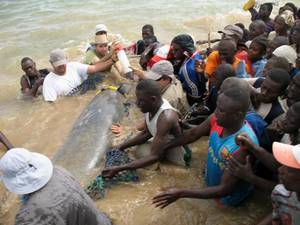 Lucy: Where are the populations' boundaries? Where are areas where genetically these manatees might be very different from other populations and therefore more important to protect, if you want to protect biodiversity of the species? And add to that, you also now have many manmade dams throughout all major rivers in Africa that are now separating some of these populations permanently. In Mali alone, in the Niger River, you have at least 4 or 5 major dams and I just heard about a new one that's going in.
Lucy: Where are the populations' boundaries? Where are areas where genetically these manatees might be very different from other populations and therefore more important to protect, if you want to protect biodiversity of the species? And add to that, you also now have many manmade dams throughout all major rivers in Africa that are now separating some of these populations permanently. In Mali alone, in the Niger River, you have at least 4 or 5 major dams and I just heard about a new one that's going in.
So, you've actually chopped up the population there into these 4 or 5 different groups that can never mix again and interbreed. Going forward in the future, if we hope to conserve these animals it's really important to know how different they are from each other or how similar.
Helen: To work out where those natural and manmade boundaries lie, a genetic study is underway, using tissues samples from wherever Lucy can get them.
Lucy: It's very difficult to get the samples, the manatees either have to be dead, unfortunately, or else captured alive and sampled. And there really aren't many people able to capture, safely, a live manatee. There are a few cases where the animals are rescued and released. But, unfortunately, most of the samples do come from manatees that are dead, either from natural causes or through hunting.
Helen: Another aspect of manatee ecology that Lucy and her team are investigating is what they eat. In parts of their range where there is seagrass then that does form an important part of their diet, they also eat various other types of aquatic vegetation including floating plants like water lilies or when rivers flood, manatees swim out across what used to be dry land, and graze on grasses and shrubs.
But this can be highly seasonal, and rather than having to cope with cold winters like manatees in Florida, the West African manatees have to deal with long dry seasons when there isn't much around to eat. And that could be why, despite being famous vegetarians, Lucy is finding out this isn't always the case, West African manatees will also eat shellfish.
Lucy: I have seen manatees eating clams in Angola, in the freshwater river 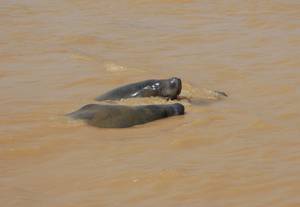 system, and some of these clam shells are quite hard to crush so it is amazing that they can do it. I'm told by the local people in Angola that they believe that the manatees are eating only the small ones or the dead clams that pop open and the clam meat would be exposed
system, and some of these clam shells are quite hard to crush so it is amazing that they can do it. I'm told by the local people in Angola that they believe that the manatees are eating only the small ones or the dead clams that pop open and the clam meat would be exposed
Helen: To get more information about manatee diets, Lucy is carrying out a stable isotope analysis - this involves taking samples of body tissues, like hair and bone, and examining the chemical fingerprint that's left behind when manatees eat particular types of food. That way she's building a picture of what they eat across their range. Another thing she's discovering is that in some places, manatees and people are sometimes chasing after the same food.
Lucy: Another thing that we got a lot of reports of, and in one place I've verified it to be true, is that the manatees take fish from nets. And, again I think this partially goes back to this dry season fasting or very little food resources available for them in the dry season. They do take fish out of fishermen's nets , they actually suck the fish meat off the fish and leave the head in the net, which of course doesn't make the fishermen very happy.
But in a way I think it's kind of ingenious; they need food, they need protein, and when they don't have many other choices. For example, up in Senegal, in Eastern Senegal in the river during the dry season they are clearly taking fish from nets; there is no other large animal in the system that would be able to do that.
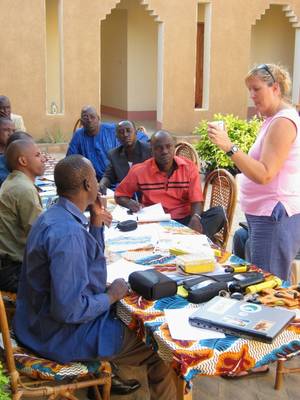 Helen: An important part of Lucy's work involves collaborating with local people, in the case of the fishermen who are having their catches eaten by manatees helping them to avoid competing for the same food. She is also tapping into local knowledge of these illusive animals, and nurturing a network of researchers to help with her work in the many West African countries that manatees live in.
Helen: An important part of Lucy's work involves collaborating with local people, in the case of the fishermen who are having their catches eaten by manatees helping them to avoid competing for the same food. She is also tapping into local knowledge of these illusive animals, and nurturing a network of researchers to help with her work in the many West African countries that manatees live in.
Lucy: They figure, prominently in the cultures where people have hunted them for generations, they are often tied to legends and myths of a spirit called Mamiwata; but those places are often very remote and there isn't a lot of contact with the outside world. So, they may know they live there but those of us who try to do conservation work you literally have to go to places and ask people, they are just not well known where they exist. And, I think that is a problem for conservation because as I said they are heavily hunted throughout most of their range.
One of the things that I've been trying to do is build a network of African Scientists in their own countries. There is a lot of interest to protect manatees, but they don't have a lot of resources to do that. So, people that I've been working with and training over the last 3 years are usually affiliated with a university or a non-profit organization or government. And they want to start doing manatee work but don't know where to begin.
We bring these people for one to two weeks of training where we tell them about manatees but we also take them in the field and teach them how to use sampling equipment and how to search for manatees and how to conduct a village interview in a way that doesn't give the people leading questions.
So I am trying to build this network, not only to get information about the manatees but to collect the samples so that we can start to analyze things like population size, what they are eating, and what they need to be protected.
Find out more:
In search of Mami Wata, Lucy Keith Diagne's research blog
West African manatee research and conservation, Sea to Shore
Collaborative regional network for West African manatee research, Sea to Shore

30:35 - Critter of the Month - Stoplight fish
Critter of the Month - Stoplight fish
with Edie Widder, Ocean Conservation and Research Association
There is this wonderful deep sea fish. It's not very common so it doesn't really have a common name, but sometimes it is referred to as the stop light fish. And it has light organs under its eye like a lot of deep sea fish to help it see in the dark.
But in most deep sea fish that have these headlights they're blue because if you have ever opened your eyes under water everything looks blue because blue is the color that travels furthest in sea water, other colors are absorbed. So this fish has a blue light organ. And like most fish it can see blue light, but it also has a red light organ and most fish can't see red light but this fish can.
So, it uses its bioluminescence like a sniper scope. This fish was actually the inspiration for the camera system called "The Eye in the Sea" that I developed to be able to observe unobtrusively in the deep ocean.
So, if I were going to come back as a deep sea animal I want to come back as this fish. You could swim around in the ocean and observe life in the ocean, but be unseen, be unobtrusive.
And, I just think that that's the most amazing adaptation, to be able to sneak up on other animals. Of course it has to get pretty close because the red light doesn't travel very far. But still, it can sneak up very close to other animals, see them, and not be seen.










Comments
Add a comment